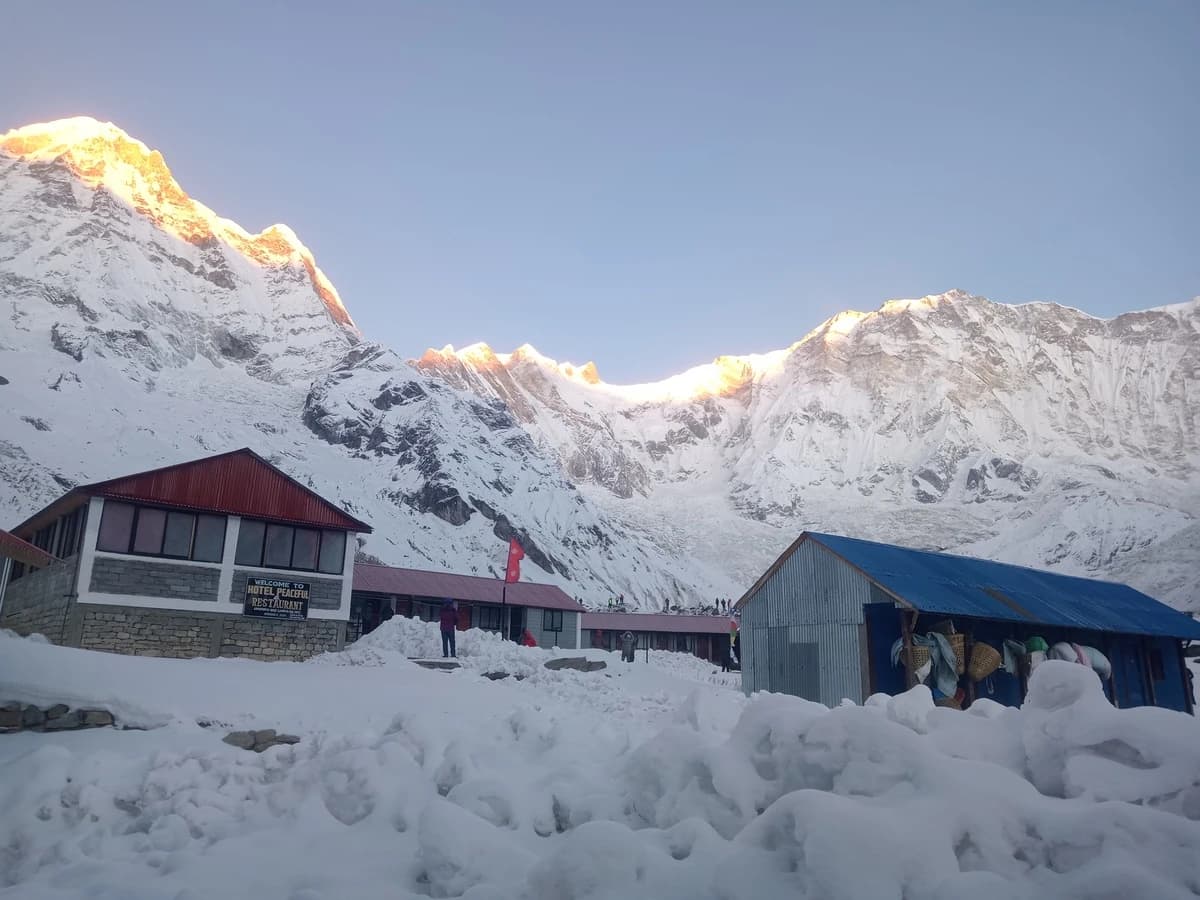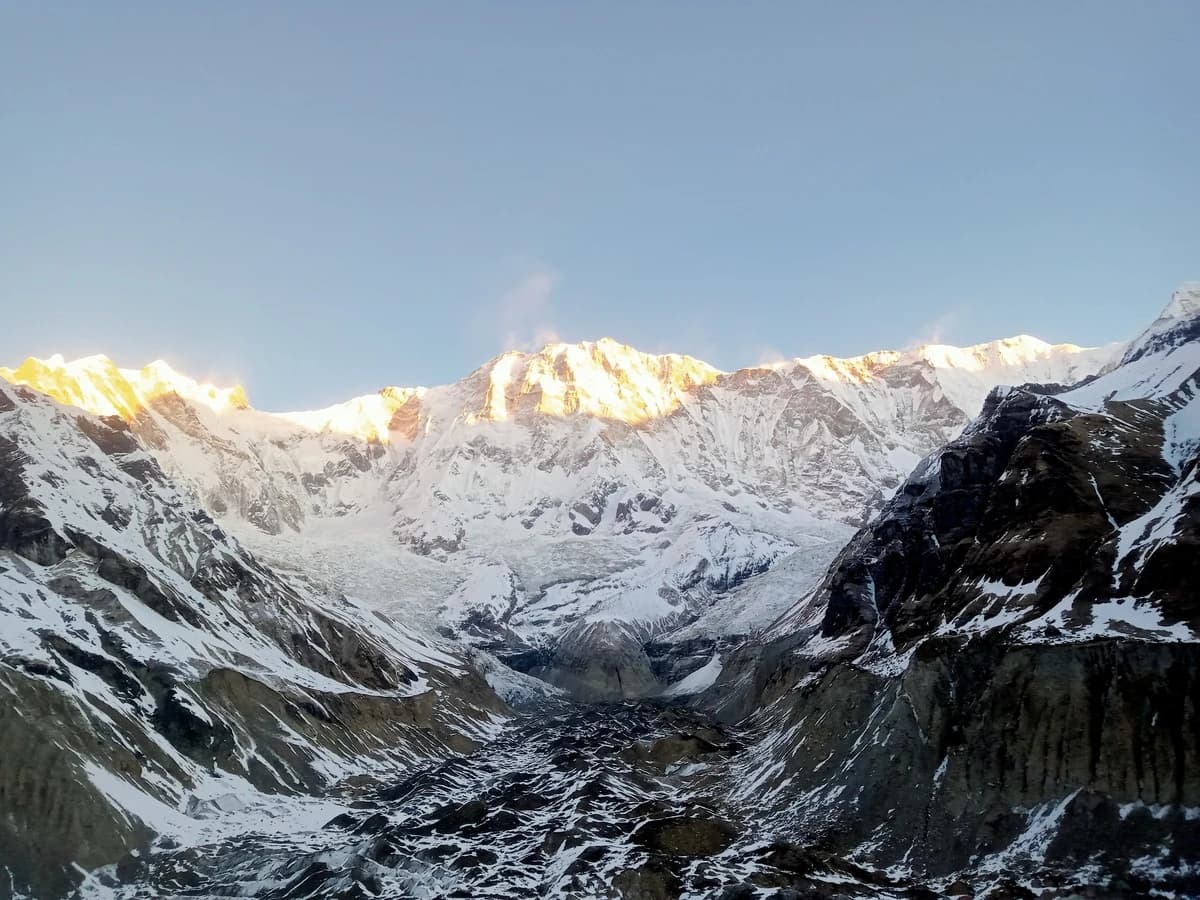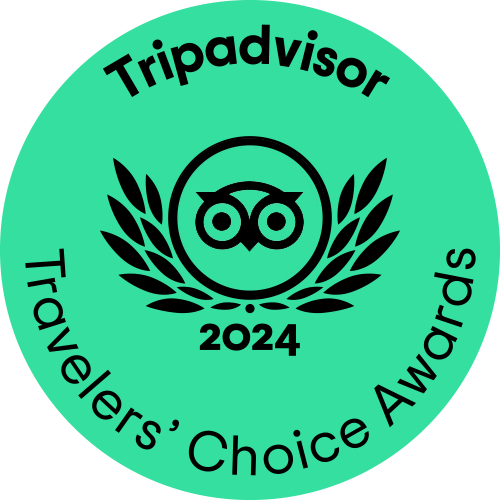The Annapurna Base Camp is one of the most popular trekking destinations in Nepal located at 4,130 meters/ 13,550 feet, where you will get a close experience of the Himalayan mountain range. You will be witnessing the world's 10th highest mountain in the world also known as killer mountain, causing numerous avalanches in Annapurna Base Camp can be encountered during the trek.
From the starting point of the trek, you will be welcomed with the alluring snow-capped mountains of Annapurna Massif, including Annapurna I (8,091m / 26,545 ft), the 10th highest peak in the world. Annapurna South (7,219m / 23,684 ft), Annapurna II (7,937m / 26,040 ft), Annapurna III (7,555m / 24,787 ft), Annapurna IV (7,525m / 24,688 ft), other mountains such as Machhapuchhre or Fishtail Mountain (6,993m / 22,943 ft), Gangapurna (7,455m / 24,459 ft), Hiunchuli (6,441m / 21,132 ft)
The trek to Annapurna Base Camp is moderate-level trek where you will be walking through the lush green forest, If you are trekking in spring, you will feel pleasing experience the lush green forest and blooming rhododendron flowers and other wild, natural vibrant flower making the landscape of the Annapurna Region more alluring, looking like a dreamland.
Along the trekking trail, you will experience the best hospitality of the Gurung communities, old settlements, old houses, traditional farming, and cultural homestays where you can experience village life and immerse yourself in the Gurung culture.
Relatively to other trekking trails, the route to Annapurna Base Camp is well-maintained, less steep, and safe from wildlife, and basic hotels and teahouses owned by the locals along the trail make it accessible for trekkers. This trek offers a perfect blend of natural beauty, cultural immersion, and a true sense of Himalayan adventure.
Highlights of the Annapurna Base Camp Trek
- Stunning close-up views of Annapurna I (8,091 m), Machapuchare (Fishtail), Hiunchuli, and other Himalayan giants.
- Stunning views of the sacred Machhapuchhre from the Machhapuchhre Base Camp (3700m)
- Trek through lush rhododendron forests, terraced farmlands, bamboo forests, alpine meadows, and glacier valleys.
- Experience the warm hospitality of local Gurung and Magar communities in villages like Ghandruk and Chhomrong.
- Relax your tired muscles in the natural hot springs near Jhinu Danda after days of trekking.
- Spotting Himalayan wildlife like Himalayan thar, langurs, and vibrant birds.
How difficult is the Annapurna Base Camp Trek?
The Annapurna Base Camp Trek is considered a moderate trek, not too easy, but not extremely hard. You have to walk for about 6–7 hours a day, covering hills, well-maintained stone steps, and mountain trails. The highest point is 4,130 meters (13,550 ft), where the air is thinner, so you need to walk slowly and let your body adjust to the altitude.
You don’t need to be a professional fitness expert, but you should have daily fitness activities, regular hiking, walking, or jogging before the trek will help to increase your stamina for a successful trek. The trail has some steep uphill and downhill sections, especially at Ulleri and Chhomrong, which can be a tiring and challenging part. Weather can change quickly, so you need to carry proper gear, including warm clothes and rain jackets.
With good preparation, hiring a guide or porter (especially for beginners), and keeping a positive attitude, the Annapurna Base Camp Trek is achievable for most beginner trekkers and adventure lovers which offering a truly rewarding Himalayan experience!
How much does it cost for the Annapurna Base Camp trek?
The Annapurna Base Camp Trek basically costs $600 to $1,200 per person for a 10–12 day package.
This cost usually includes all essential services: trekking permits, guide and porter, local transportation (Kathmandu–Pokhara–Nayapul), teahouse accommodation, and meals during the trek. We also arrange your hotels in Kathmandu and Pokhara before and after the trek.
For a more comfortable or luxury experience, packages can be planned according to your time and budget preference can include private rooms, upgraded hotels, cultural tours, or even a helicopter return from base camp (if needed), raising the price to $1,500–$2,500 depending on your preferences.
All personal expenses like travel insurance, tips, drinks, gear rentals, and optional extras (hot showers, WiFi, charging devices) are usually paid separately.
Why trek to Annapurna Base Camp with us?
Trekking to Annapurna Base Camp with View Nepal Trek & Expedition means you’ll get the best care, safety, and experience. Our experienced local guides and porters know the trails well and will help you every step of the way, making sure you feel safe, comfortable, and enjoy the experience.
We offer flexible packages to fit your style, whether you’re looking for a budget trip or a more luxurious adventure, we can arrange it for you. We choose the best teahouses for clean, cozy rooms and healthy meals, so you can rest well each night.
We also organize small group or private treks, allowing you to enjoy a personal, relaxed journey at your own pace. We also believe in responsible travel, supporting local communities, and eco-friendly tours.
From the moment you contact us until you complete your trek, we provide full support and smooth planning, so you can simply enjoy the beauty of the Annapurna Massif.




